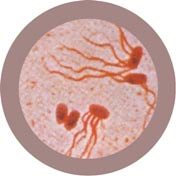Definition
Typhoid fever is a food borne illness caused by a bacterium, Salmonella typhi.

salmonella typhi
Transmission modes
Transmission may be:
– Direct stools or soiled linen, by eating contaminated food.
– Indirect shellfish, seafood, water polluted with faecal material.
Pathophysiology
– Ingestion of the organism that crosses the intestinal mucosa.
– The seed wins the lymph nodes, where it multiplies.
– Germs are released into the blood via the lymphatic system: lymphatic sepsis.
– Lysis of the bacteria releases toxins that cause digestive complications and myocarditis.
Clinical
1.Incubation is variable between 7 and 15 days.
2.Fever : the temperature reaches 40 ° and then gradually plateau.
3.Digestive disorders: abdominal pain, constipation or diarrhea.
4.Dissociation pulse / temperature.
Diagnosis
To confirm the diagnosis of clinical signs, Usually sets of blood cultures are made .
Complications
1.Intestinal bleeding.
2.Intestinal perforation.
3.Myocarditis slow.
4.Encephalitis.
5.Prophylaxis
Immunization is not mandatory.
Measurement and dietary isolation, personal items, mandatory reporting.
Hygiene: individual and food.